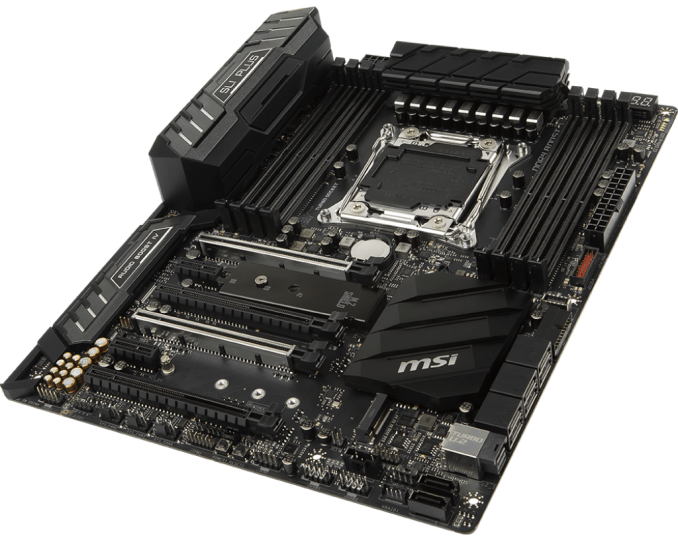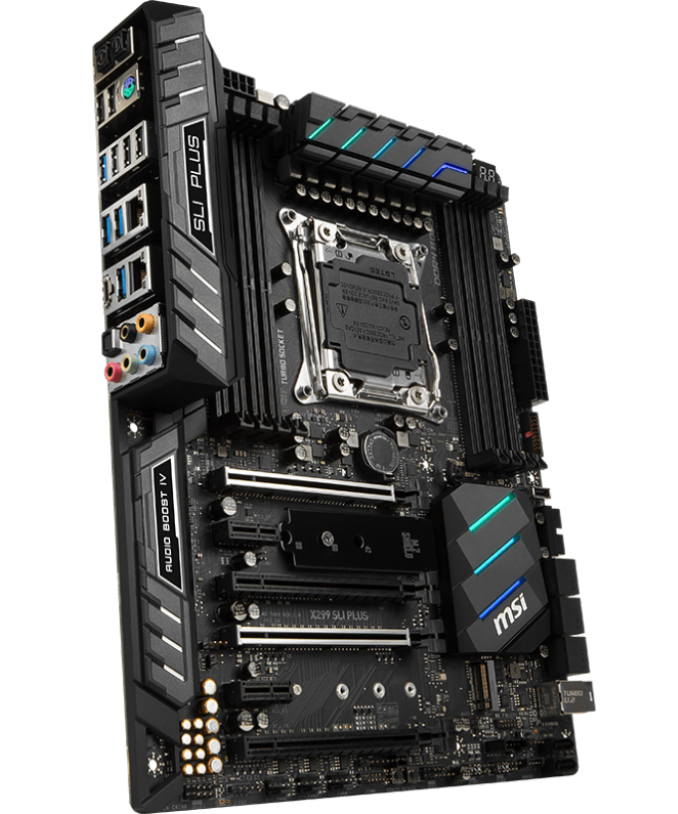The MSI X299 SLI Plus Motherboard Review: $232 with U.2
by Joe Shields on November 29, 2017 8:00 AM EST- Posted in
- Motherboards
- MSI
- X299
- Skylake-X
- Kaby Lake-X
- SLI Plus
Conclusion
The X299 SLI Plus is currently priced at $231.89 (from $259.99) at Amazon.com and $260 at Newegg. The SLI Plus competes with boards such as the ASUS TUF X299 Mark 2 ($260 w/Free Assasin's Creed Game), the Gigabyte X299 AORUS Gaming 3 ($250), as well as the ASRock X299 Gaming K6 ($250) by price.
The SLI Plus is ultimately targeted towards the professional side of computing, being in MSI's 'Professional' line, but it will have a wide appeal given its price. Although it is missing the 10 Gigabit Ethernet, it does gives users options with the dual Intel NICs with the I219-V and the I211-AT devices. Included with the SLI Plus is the seemingly rare Turbo U.2 port for connecting U.2 type storage. It does share bandwidth with the third PCIe slot, but it is not the preferred GPU slot and likely won't be missed when it is disabled. The two M.2 slots share bandwidth with the SATA ports so users will have to aware of this and which port(s) will be disabled when using each slot; it does differ as we found earlier in the review.
While gaming isn't a primary focus on this board given its position, the slot configuration allows for up to three-way SLI and Crossfire gaming. If a triple slot GPU is used, there is space for it without losing the next GPU slot which allows for a larger selection of cards, either for compute purposes or for gaming too. The popular ALC1220 codec is used for audio and has many of the features users want with an auto-detect high-impedance headphone jack (to 600Ω), Chemicon audio capacitors, de-pop and ESD protection, as well as an isolated audio design to ensure a pure audio signal.
RGB LEDs are not a major aesthetic feature on the SLI Plus as only the VRM heatsink and chipset heatsink have them. The DRAM slots have a white LED that syncs with them; outside of that, the RGB LED headers on the board allow for expansion if needed.
Overclocking on the SLI Plus topped out at the same speed of 4.5 GHz as the Tomahawk, an expected result with this CPU. The Click 5 BIOS OC section had all the options I needed to adjust all within that section which made for easy tweaking. The Command Center software worked well in changing the voltage and CPU multiplier during testing and didn't have any issues adjusting the fan speeds.
The MSI SLI Plus is a well-rounded X299 board offering those who buy it plenty of connectivity, although nothing too extreme over the base X299 feature set. The set of USB 3.1 (10 Gbps) ports, the dual Intel Gigabit NICs, the two M.2 slots and the U.2 port means that the SLI Plus has those bases covered.
If extreme work (or extreme play) activities warrant the need for 10 Gigabit network, other more expensive boards will need to be on your wish list, or a user will need to buy a 10G card. For example. at a nearby price point of $260, the ASUS X299 TUF Mark 2 doesn't offer U.2 connectivity, has fewer USB ports, a single network port, and no onboard RGB LEDs, as the extra money ends up elsewhere. Aesthetics, included software, game bundles and price separate many boards around this price point.
The MSI X299 SLI Plus motherboard is very reasonable solution for its intended user base.












20 Comments
View All Comments
Vatharian - Wednesday, November 29, 2017 - link
Why, why manufacturers won't let the U.2 die? We are already past SATA Express, and now this. I get it, it's one of the most popular connectors to connect SAS backplanes, and most of HBAs and RAID controllers do use it, but please, let it die in desktop space. If anything SFF8087 should remain, as SFF-8639 (U.2) is much flimsier and easier to break.Also, we already have far superior standard just behind the corner, in the form of OCuLink.
peterfares - Wednesday, November 29, 2017 - link
Why not have it there though? X299 is a prosumer platform, they may want to use U.2 drives.Lolimaster - Wednesday, November 29, 2017 - link
x399 laughs at X299 being called "prosumer" 44pci-e lanes vs 64 pci-e lanes, bootable nvme raid support.BillyONeal - Wednesday, November 29, 2017 - link
I'm a "prosumer" who built both X299 and X399 boxes and couldn't care less about those things. Compiler want MOAR CORRRREEEESSSSSSdrajitshnew - Friday, December 1, 2017 - link
Why call it a prosumer product when it doesn't have ANY m2/u2 connected to the processor?andychow - Wednesday, November 29, 2017 - link
Doubtful it will disappear. With Optane coming out with only a U.2 connector on the SSD format, it rather insured that U.2 will grow in demand.BillyONeal - Wednesday, November 29, 2017 - link
The 750 was also like that but didn't spur demand for U.2. The add-in cards are just fine.Dr. Swag - Wednesday, November 29, 2017 - link
Could you guys do some better vrm testing? X299 vrms have been a hot topic (pun intended) due to Skylake X drawing a lot of power when OCed and because of the addition of up to 18 cores. Some vrms get quite toasty under load so if you guys had good vrm temp measurements and perhaps even measurements on voltage ripple and stuff coming out of the vrm that would be awesome.vgray35@hotmail.com - Wednesday, November 29, 2017 - link
And let's not forget measurement of VRM power efficiency to compare the quality of VRMs across motherboards!Lolimaster - Wednesday, November 29, 2017 - link
Just but Threadripper and forget about those problems.